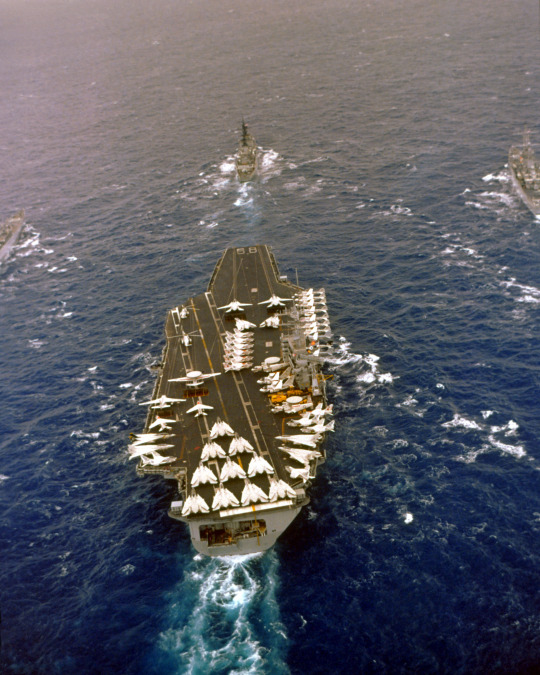#USS Nimitz
Explore tagged Tumblr posts
Text

Giddy up 💨
An F-35C Lightning II from Strike Fighter Squadron (VFA) 86 launches from the flight deck of the aircraft carrier USS Nimitz (CVN 68), currently underway in the Pacific Ocean.
@TheF35JPO via X
20 notes
·
View notes
Text
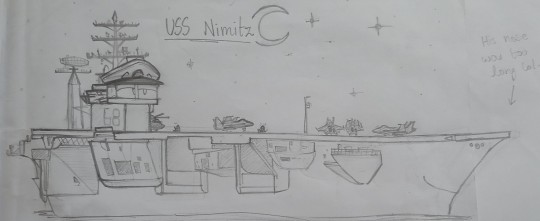
I drew USS Nimitz instead of studying last night *chuckle*
Haha cringe camera quality as well :')
Anyway it was an experimental try and uhh he looks a little off because I ended up making him tinier because i drew him in a horizontal way instead of vertical in the book lol. His nose was literally to long to fit
Anyway, here's some hcs about my boy since i dunno what else to say:
-Is always seen bright and fine. He hides his feelings for others. Is calm and composed during stressful situations lol.
-Is very protective of his class ships. Is a father-figure for all of them
-Outgoing, determined, courageous, supportive, still wise, overprotective sometimes.
-Snores l o u d l y (credit to @thatonelightyear )
-Goofy guy, is capable of being more annoying than the naughty ones in his crew
I will got lotta think 'bout lol but yeah.
18 notes
·
View notes
Text
#buildream 1/432 #ussnimitz #cvn68 #usnavy #aircraftcarrier #modelship #modelbuilding #postworldwar2 #postww2 #postworldwarii #postwwii #3dpuzzle #buildreammodel #ussnimitzcvn68 It was going to be a big build, but I knocked it out in about 40 mins. I'm not going to build anything this big again, because it is massive.

#Instagram#original content#buildream#uss nimitz#cvn 68#us navy#aircraft carrier#model ship#model building#post world war 2#post ww2#post world war ii#post wwii#3d puzzle#buildream model#uss nimitz cvn 68
1 note
·
View note
Text
Titans of the Sea: The Power and Influence of Nuclear-Powered Aircraft Carriers
Introduction

Nuclear-powered aircraft carriers represent the pinnacle of naval engineering and strategic military capability. The USS Nimitz (CVN 68), the lead ship of its class, exemplifies the power and versatility of these floating fortresses. Coupled with formidable aircraft like the F/A-18 Hornet, the USS Nimitz and its counterparts serve as crucial assets in projecting military power and maintaining global security. This essay delves into the design, capabilities, and strategic importance of nuclear-powered aircraft carriers, with a special focus on the USS Nimitz and its fleet of F/A-18 Hornets.
Evolution of Nuclear-Powered Aircraft Carriers
The concept of nuclear-powered aircraft carriers emerged during the Cold War as nations sought to extend the reach and endurance of their naval forces. Unlike conventional diesel-powered ships, nuclear-powered carriers do not require frequent refueling, allowing them to remain deployed for extended periods and operate at higher speeds.
The USS Enterprise (CVN 65), commissioned in 1961, was the world’s first nuclear-powered aircraft carrier. Its success paved the way for the development of the Nimitz-class carriers. The USS Nimitz, commissioned in 1975, was the first of ten nuclear-powered carriers in this class. These ships have since become the backbone of the U.S. Navy, embodying the principles of sustained power projection and rapid response.
Design and Capabilities of the USS Nimitz
The USS Nimitz is an engineering marvel, measuring over 1,092 feet in length and displacing around 100,000 tons. It can accommodate a crew of approximately 5,000 personnel, including the ship's company and the air wing. Its flight deck spans about 4.5 acres, providing ample space for the launch and recovery of various aircraft.
Powered by two A4W nuclear reactors, the USS Nimitz can achieve speeds in excess of 30 knots. These reactors provide the ship with nearly unlimited operational range, limited only by the need for resupply of food and other consumables. The ship's propulsion system, combined with its advanced navigation and control technologies, enables it to maneuver effectively even in challenging conditions.
The USS Nimitz is equipped with a robust suite of defensive systems, including the RIM-7 Sea Sparrow and RIM-116 Rolling Airframe Missiles, which provide protection against aerial threats. Additionally, the Phalanx Close-In Weapon System (CIWS) offers a last line of defense against incoming missiles and aircraft. The ship’s radar and sensor systems ensure comprehensive situational awareness, enhancing its defensive and offensive capabilities.
The Role of F/A-18 Hornets
Fighters like the F/A-18 Hornet is a twin-engine, multirole fighter aircraft designed for carrier-based operations. Its versatility allows it to perform a wide range of missions, including air superiority, ground attack, reconnaissance, and close air support. The Hornet has been a mainstay of the U.S. Navy's air wings since its introduction in the 1980s and continues to be a vital component of carrier strike groups.
The F/A-18 Hornet’s design emphasizes survivability and versatility. It features advanced avionics, reduced radar cross-section, and electronic warfare capabilities, making it a formidable opponent in air combat. Its twin-engine configuration provides redundancy and improved performance, particularly important for operations from the demanding environment of an aircraft carrier.
One of the key advantages of the F/A-18 Hornet is its ability to switch roles rapidly. It can carry a diverse array of ordnance, from air-to-air missiles to precision-guided bombs, enabling it to engage both aerial and ground targets with high effectiveness. This flexibility is crucial for modern naval operations, where threats can emerge from multiple domains simultaneously.
Strategic Importance of the USS Nimitz
The USS Nimitz serves as a mobile airbase, capable of projecting power and deterrence far beyond U.S. territorial waters. Its presence in a region can significantly influence the strategic calculations of potential adversaries. The carrier’s ability to deploy a wide array of aircraft, including the F/A-18 Hornet, allows it to conduct sustained air operations over extended periods.
One of the primary missions of the USS Nimitz is to ensure freedom of navigation and the security of maritime trade routes. Given that a significant portion of global trade passes through strategic chokepoints like the Strait of Hormuz and the South China Sea, the carrier’s ability to operate in these areas is of paramount importance. Its deployment can reassure allies and deter aggression, contributing to regional stability.
In times of conflict, the USS Nimitz can serve as a command and control hub, coordinating the actions of various naval, air, and ground forces. Its air wing, centered around aircraft like the F/A-18 Hornet, can perform a wide range of missions, from establishing air superiority to providing close air support for ground troops. The carrier’s versatility makes it a critical asset in both conventional and asymmetric warfare scenarios.
The Future of Carrier Aviation
While the USS Nimitz and its sister ships remain at the forefront of naval power, the future of carrier aviation is evolving. New classes of carriers, such as the Gerald R. Ford-class, incorporate advanced technologies like electromagnetic aircraft launch systems (EMALS) and advanced arresting gear (AAG). These innovations aim to improve the efficiency and capability of carrier operations, allowing for the deployment of next-generation aircraft.
Additionally, the integration of unmanned aerial systems (UAS) into carrier air wings represents a significant shift. Drones like the MQ-25 Stingray, designed for aerial refueling, will extend the range and endurance of manned aircraft like the F/A-18 Hornet. This development will enhance the operational flexibility of carrier strike groups, allowing them to project power even further.
Furthermore, advancements in stealth technology and electronic warfare are likely to shape the future composition of carrier air wings. Aircraft like the F-35C Lightning II, with its advanced stealth and sensor capabilities, are expected to complement and eventually replace older platforms like the F/A-18 Hornet. These next-generation fighters will ensure that carrier strike groups remain at the cutting edge of military capability.
Conclusion

Nuclear-powered aircraft carriers, epitomized by the USS Nimitz, are critical instruments of naval power and global stability. Their ability to operate independently for extended periods, combined with the versatile capabilities of aircraft like the F/A-18 Hornet, makes them indispensable to modern military strategy. As technological advancements continue to shape the future of carrier aviation, the legacy of the USS Nimitz and its contributions to naval warfare will endure, ensuring that these floating fortresses remain at the heart of American naval dominance for decades to come. The integration of new technologies and platforms will further enhance their operational effectiveness, enabling them to meet the evolving challenges of global security.
0 notes
Text

An aerial stern view of the nuclear-powered aircraft carrier USS NIMITZ (CVN-68) returning to home port in Norfolk, Virginia, on May 28 1981.
171 notes
·
View notes
Text

🔴E-2C Hawkeye Land On Nimitz-Class Aircraft Carrier
PACIFIC OCEAN (Aug. 7, 2007) - An E-2C Hawkeye, attached to the squot; Golden Hawks squot; of Carrier Airborne Early Warning Squadron (VAW) 112, lands on the flight deck of the Nimitz-class aircraft carrier USS John C. Stennis (CVN 74) after completing a training mission as part of exercise Valiant Shield 2007. The John C. Stennis, Kitty Hawk and Nimitz Carrier Strike Groups are participating in Valiant Shield 2007, the largest joint exercise in recent history. Held in the Guam operating area, the exercise includes 30 ships, more than 280 aircraft and more than 20,000 service members from the Navy, Air Force, Marine Corps, and Coast Guard. U.S. Navy photo by Mass Communication Specialist 3rd Class Jon Hyde
#military#aircraft#air force#us air force#usaf#fighter jet#aviation#fighter plane#plane#us navy#us marines#E-2C Hawkeye#aircraft carrier#aviation photography#aviation history#military aviation#pacific ocean#USS John C. Stennis#CVN 74#Nimitz-class#kitty hawk#Nimitz Carrier Strike Groups
33 notes
·
View notes
Text

"Proceedings Photo of the Week: Sailors pet Lucky, a therapy dog from the Alliance of Therapy Dogs, in the hangar bay onboard Nimitz-class aircraft carrier USS RONALD REAGAN (CVN-76) as the ship prepares to depart Naval Air Station North Island, California."
Photographed by Charlotte Dudenhoeffer on August 10, 2024.
Posted on the U.S. Naval Institute Facebook page: link
#USS RONALD REAGAN (CVN-76)#USS RONALD REAGAN#Nimitz Class#Aircraft Carrier#Warship#Ship#United States Navy#U.S. Navy#US Navy#USN#Navy#Naval Air Station North Island#California#West Coast#August#2024#my post
25 notes
·
View notes
Text
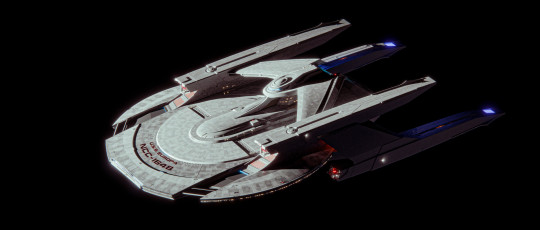
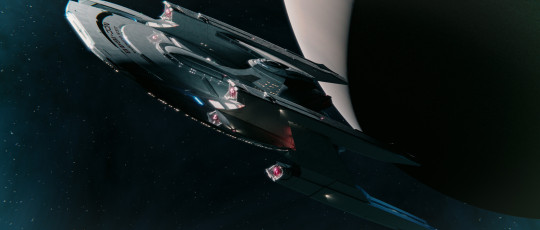
Star Trek: Discovery - USS Europa by Joel Durham
#Star Trek#Star Trek: Discovery#Federation#STarfleet#Nimitz Class#USS Europa#Sci-Fi#Mecha#Spaceship#Joel Durham
70 notes
·
View notes
Text
⚓️
#tempted by another wip#i need to stop#this one is azur lane#and a crossover with the final countdown#you know#that old movie with kirk douglas as the captain of the uss nimitz#shipgirls
1 note
·
View note
Text
Today’s Problematic Ship is the USS Harry S. Truman


The USS Harry S. Truman is a Nimitz-class nuclear powered aircraft carrier. Late at night, local time, on February 12, 2025, near Port Said, Egypt, the northern mouth of the Suez Canal, the 332 m, 100 000 tonne warship collided with the M/V Besiktas-M. The latter is a Panama-flagged, 188.5 m, 53000 tonne bulk carrier. As of February 13, the extent of the damage to either ship is unknown, but there are so far no reports of casualties aboard.
482 notes
·
View notes
Text

A F/A-18F Super Hornet, assigned to the “Bounty Hunters” of Strike Fighter Squadron (VFA) 2, recovers on the flight deck of Nimitz-class aircraft carrier USS Carl Vinson (CVN 70), the Pacific Ocean on March 26, 2023. Photo by Seaman Leon Vonguyen, USS Carl Vinson
229 notes
·
View notes
Note
Came across this ig post claiming there's going to be a false flag attack against the USS Nimitz. Is there anything to it? https://www.instagram.com/p/DLK32jSRWS8/?igsh=NDhnZDJhaGRvZWNi
99% of the time you hear someone talking about false flag attacks, they're full of shit. That post is an example
#the Israeli attack on the USS Liberty wasn't even an attempt at a false flag attack#everyone knew the attack was by the Israeli military and I don't think they ever claimed otherwise
50 notes
·
View notes
Text
Nuclear-Powered Aircraft Carriers and Their Role in Modern Naval Warfare
Introduction

Nuclear-powered aircraft carriers represent the pinnacle of modern naval engineering and military strategy. Among these giants of the sea, the USS Nimitz (CVN 68) stands out as a quintessential example of American naval power. Alongside it, aircraft like the F/A-18 Hornet play a crucial role in maintaining air superiority and providing versatile combat capabilities. This essay explores the design, capabilities, and strategic importance of nuclear-powered aircraft carriers, with a focus on the USS Nimitz and its accompanying fleet of F/A-18 Hornets.
The Evolution of Nuclear-Powered Aircraft Carriers
Nuclear power revolutionized naval engineering by providing ships with an almost unlimited range and endurance. Unlike conventional diesel or gas-turbine engines, nuclear reactors do not require refueling for many years, allowing aircraft carriers to stay at sea for extended periods. This capability is critical for maintaining a persistent military presence and quick response capability anywhere in the world.
The introduction of nuclear power to aircraft carriers began with the USS Enterprise (CVN 65) in the 1960s. This technological leap forward set the stage for the subsequent Nimitz-class carriers, which would become the backbone of the U.S. Navy's carrier strike groups. The USS Nimitz, commissioned in 1975, was the first of its class and remains a formidable asset in the Navy's arsenal.
Design and Capabilities of the USS Nimitz
The USS Nimitz is a marvel of engineering, measuring approximately 1,092 feet in length and displacing over 100,000 tons. It can accommodate a crew of over 5,000 personnel, including air wing and support staff. Its flight deck spans around 4.5 acres, providing ample space for the launch and recovery of various aircraft.
The ship's propulsion system consists of two A4W nuclear reactors, which drive four propeller shafts. This setup allows the USS Nimitz to achieve speeds in excess of 30 knots. The nuclear reactors provide the ship with virtually unlimited operational endurance, limited only by the need for resupply of food and other consumables.
The carrier's defensive capabilities are formidable, featuring multiple layers of protection against air, surface, and underwater threats. These include the RIM-7 Sea Sparrow and RIM-116 Rolling Airframe Missiles, as well as the Phalanx Close-In Weapon System (CIWS) for close-range defense.
The Role of F/A-18 Hornets
Fighters like the F/A-18 Hornet is a twin-engine, multirole combat aircraft capable of performing a wide range of missions, including air superiority, ground attack, and reconnaissance. The Hornet is highly versatile, making it an ideal aircraft for carrier-based operations. It has been a staple of the U.S. Navy's air wings since the 1980s and continues to be a critical component of carrier strike groups.
The F/A-18 Hornet's design emphasizes survivability, with features such as reduced radar cross-section, advanced avionics, and electronic warfare capabilities. Its twin-engine configuration provides redundancy and improved performance, allowing it to operate effectively from the cramped and sometimes harsh environments of aircraft carriers.
One of the key advantages of the F/A-18 is its ability to switch roles rapidly. For instance, it can carry a variety of ordnance, from air-to-air missiles to precision-guided bombs, enabling it to engage both aerial and ground targets with equal efficacy. This flexibility is crucial for modern naval operations, where threats can emerge from multiple domains simultaneously.
The Strategic Importance of the USS Nimitz
The USS Nimitz serves as a floating airbase, projecting power and deterrence far beyond the territorial waters of the United States. Its presence in a region can significantly alter the strategic calculus of potential adversaries. The carrier's ability to deploy a wide array of aircraft, including the F/A-18 Hornet, allows it to conduct sustained air operations over a prolonged period.
One of the primary missions of the USS Nimitz is to ensure freedom of navigation and the security of maritime trade routes. Given that a significant portion of global trade passes through strategic chokepoints like the Strait of Hormuz and the South China Sea, the ability of the Nimitz to operate in these areas is of paramount importance. Its deployment can reassure allies and deter aggression, contributing to regional stability.
In times of conflict, the USS Nimitz can serve as a command and control hub, coordinating the actions of various naval, air, and ground forces. Its air wing, centered around aircraft like the F/A-18 Hornet, can perform a wide range of missions, from establishing air superiority to providing close air support for ground troops. The carrier's versatility makes it a critical asset in both conventional and asymmetric warfare scenarios.
The Future of Carrier Aviation
While the USS Nimitz and its sister ships remain at the forefront of naval power, the future of carrier aviation is evolving. New classes of carriers, such as the Gerald R. Ford-class, incorporate advanced technologies like electromagnetic aircraft launch systems (EMALS) and advanced arresting gear (AAG). These innovations aim to improve the efficiency and capability of carrier operations, allowing for the deployment of next-generation aircraft.
Additionally, the integration of unmanned aerial systems (UAS) into carrier air wings represents a significant shift. Drones like the MQ-25 Stingray, designed for aerial refueling, will extend the range and endurance of manned aircraft like the F/A-18 Hornet. This development will enhance the operational flexibility of carrier strike groups, allowing them to project power even further.
Conclusion
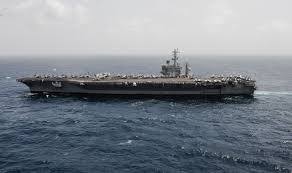
Nuclear-powered aircraft carriers, epitomized by the USS Nimitz, are critical instruments of naval power and global stability. Their ability to operate independently for extended periods, combined with the versatile capabilities of aircraft like the F/A-18 Hornet, makes them indispensable to modern military strategy. As technological advancements continue to shape the future of carrier aviation, the legacy of the USS Nimitz and its contributions to naval warfare will endure, ensuring that these floating fortresses remain at the heart of American naval dominance for decades to come.
0 notes
